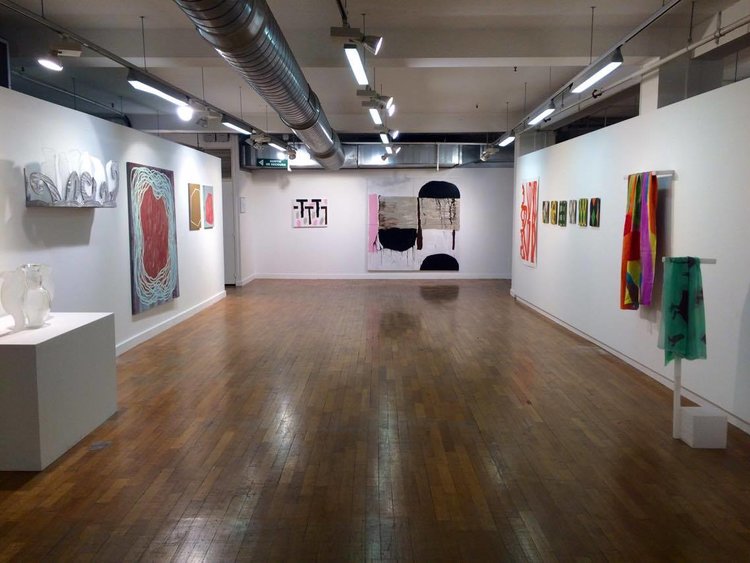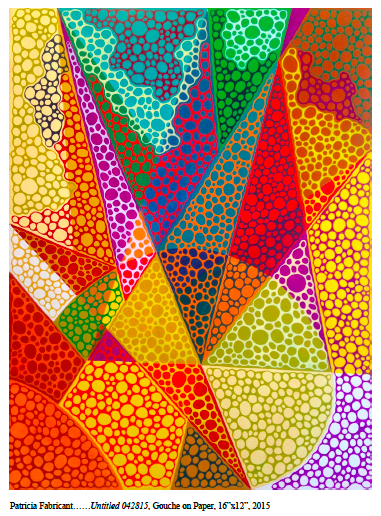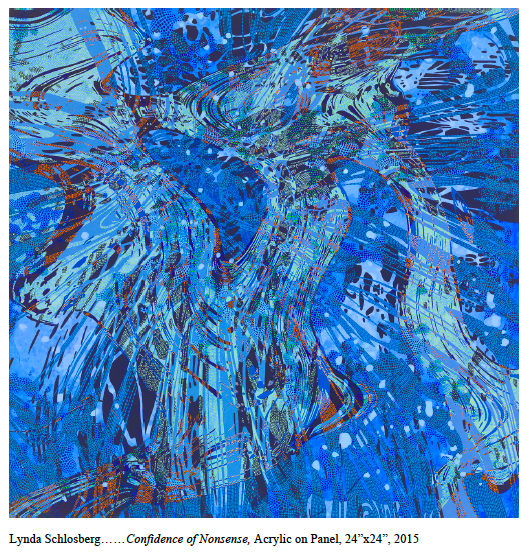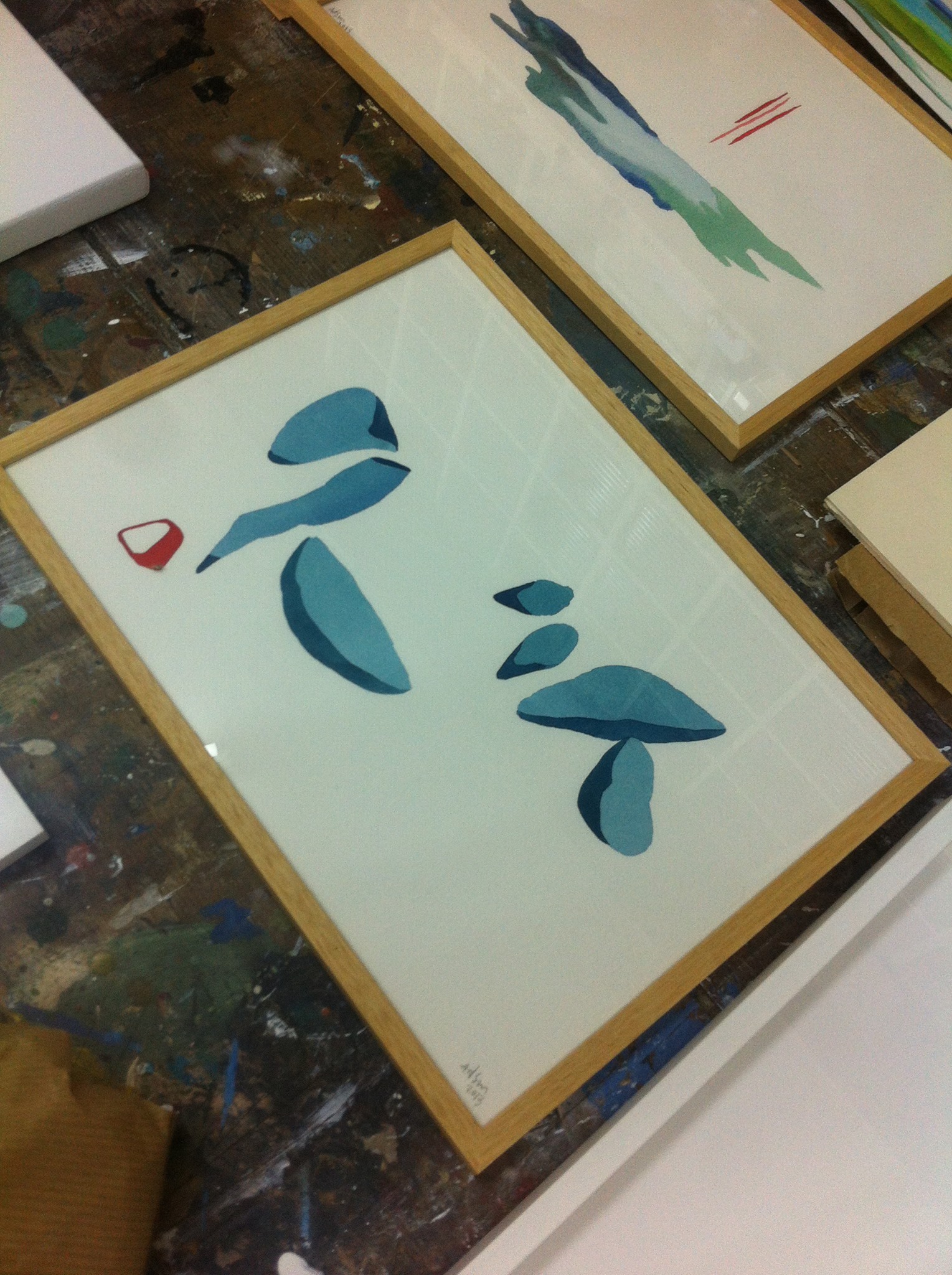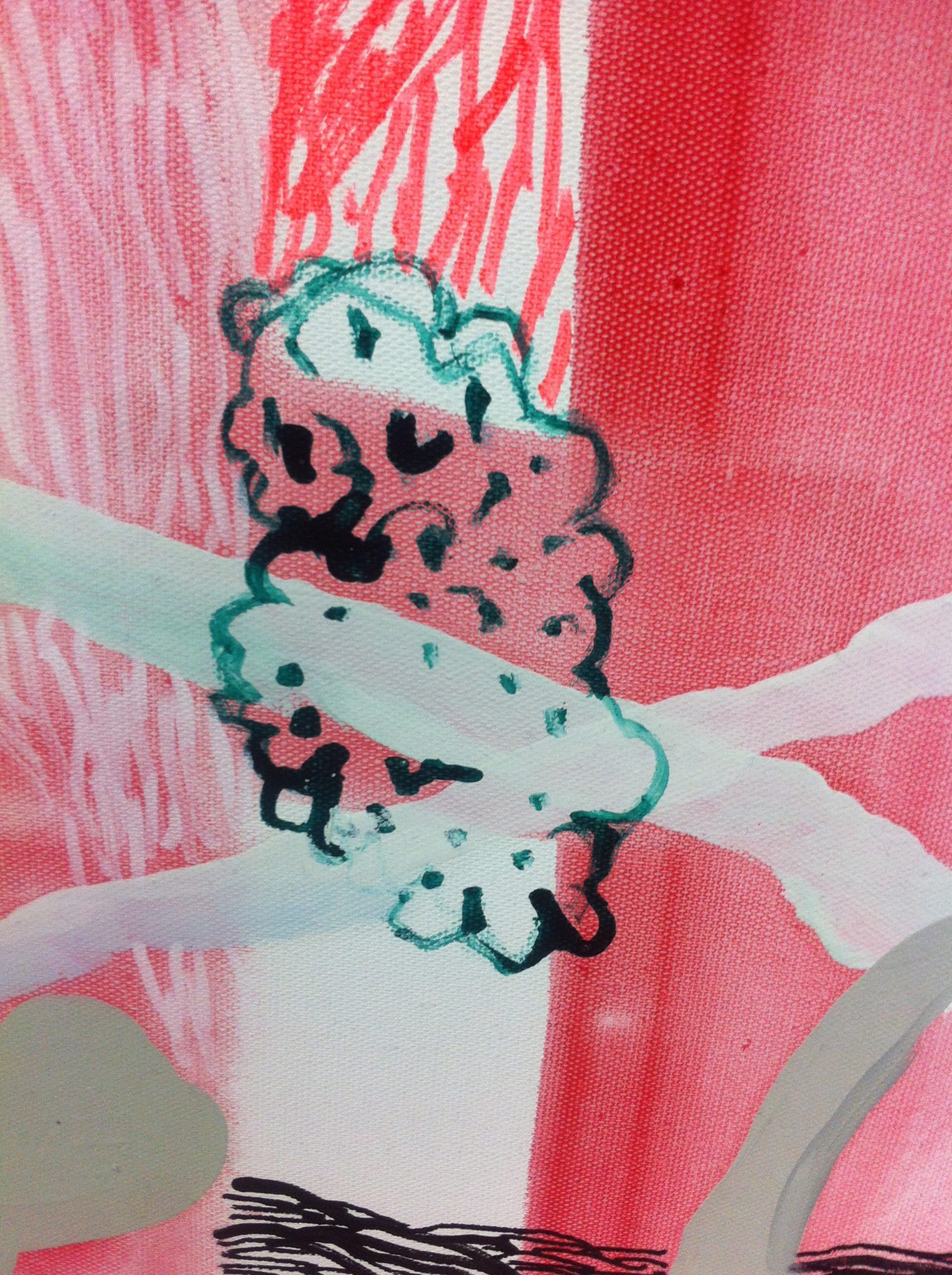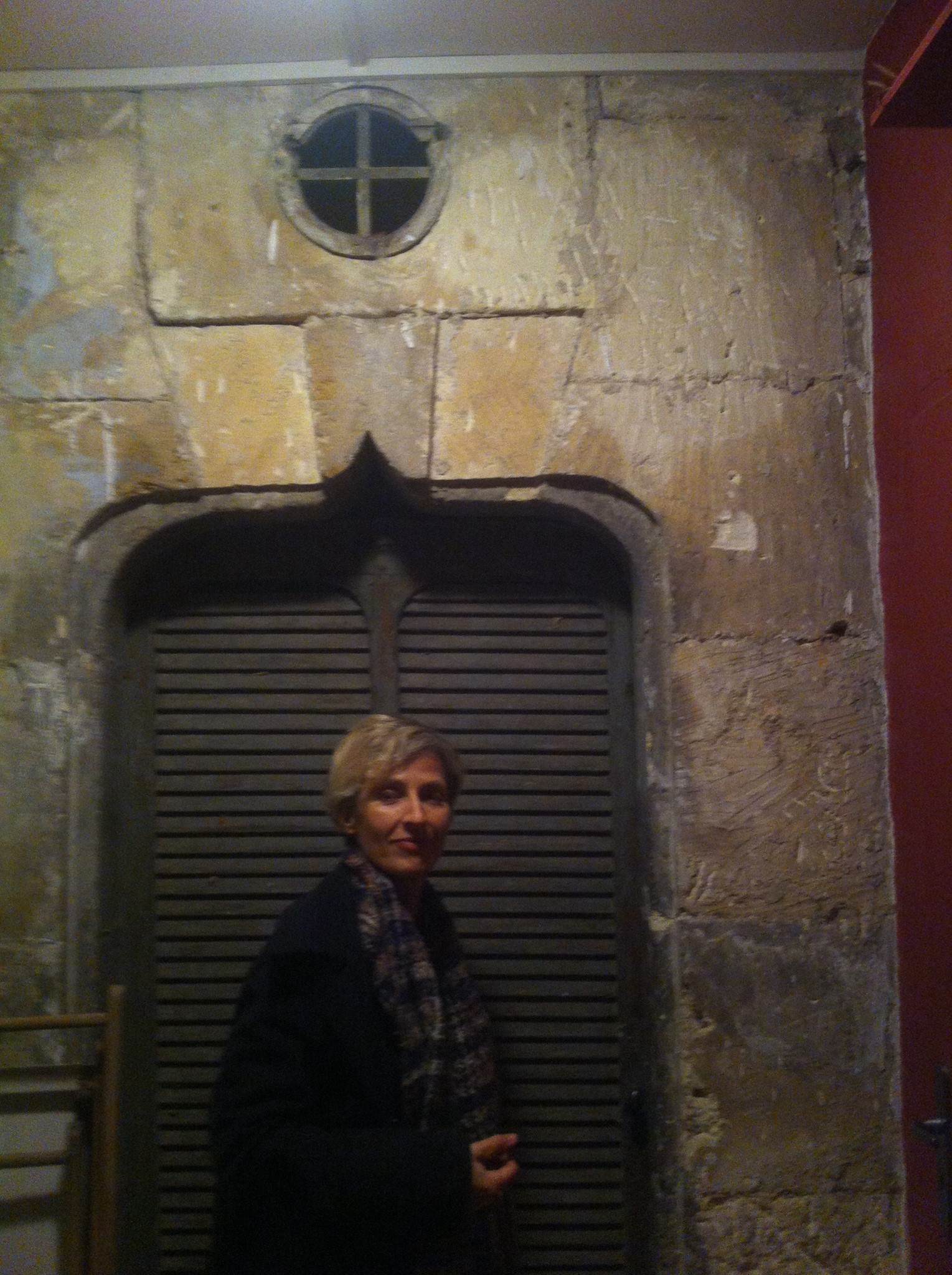Its been a while since I looked at sister corita’s . sometimes I miss her and I go back for advice. she never fails. here is rule seven out of the famous list she made for her students, that later became the LA art campus list, than populated by John Cage and known for being hanged at Merce Cunningham studio.
Les unes avec les autres...
Curated by Romain mathew
gallerie Bea-ba @ gallerie du 5eme
What are you grateful for being a painter ? #2 - by Valery Bremen
Valerie Brennan / Paphos Cyprus
I am grateful for the solitude and space being a painter. When I am in my studio working I feel in the present, in the moment and alive. I love the openness of process when I paint. Painting feels fundamental to who I am, second nature and it feels authentic. I am grateful that I am still learning
Lucy Mink Covello / New Hampshire USA
I am grateful for Steve, Gianna and Nico. I am also grateful I saw so many friends this summer. I was with my kids outside a lot this summer and inside. I watched my son learn how to fish. I am grateful to be able to go slower as a parent and a painter because things sometimes feel way too competitive and too rushed and that's not where I am. I am grateful for this summer with two kids who are not yet teenagers. I have still managed to paint in between hours here and there and during random days if they were both somewhere else.
Sabine Tress / Cologne Germany
Without wanting to be overly dramatic I must say that I don´t know how I would be able to cope with life without having my studio and my work. It´s more than just an excuse for being able to hide away from the world outside. Being a painter allows me to evolve, understand, sulk, laugh, lern, dialogue and rest. Every day is a step forward even if it sometimes does not feel this way. Yes, I am absolutely grateful for being an artist.
Susan Carr / Massachusetts usa
Painting a poem called “I am grateful”.
Painting is the moon and I am starting to howl
Painting floating inside of my teacup six in the morning OM
Painting in dusky fingered roses the sea laps my ankle
Painting on the blackboard painting on the test painting no cheating
Paint me another round and make it ultramarine this time baby
Bottom of the ninth bases are loaded and I’m up to paint
Painting fleshy pink knobby knees up to my nose nipple coral red round the top
Painting faster, faster running out of paint
Paint flickers deep in cave wall images of paint in four legs and two
And the wind cries paint
Just one more paint, just one more paint, just one more paint, just one more
If I only had a little bit more paint
In the forest of paint chop wood carry water
Tricky inclusive ironic clumsy chewy frenzied subversive highbrow lowbrow talky talk talk
Paint is on the menu
Painting next time will be the best time because this painting is almost the one but not quite, not quite
Painting dressed in black without a sound snatching the jewels under cover of night
I am not old; I am not young I am merely a painter
Painting between two day old pieces of bread painting instead of a glass of milk
Watching painting it is a very good show
Sleepy now will cover myself up in old paintings to keep warm
Hey how come you are so poor? Painting stole me away
The dream of more paint it started like this
Julia Schwartz / Santa Monica Ca
I am grateful that I have a community of friends, mentors, and heroes who have become 'my people.' Even though we so often work in solitude, it is good to know there are others out there.
It's also good to have an all access pass to art, and that can take many forms- virtual looking; seeing/being/taking in the world- light/air/sound/color; and especially the making. Making art takes so many forms- from luscious oil on linen to the low-brow dirty paint water on scrap paper, and everything in between.
Art can teach, can hold, can transform, and be transforming. I am immensely grateful for that in this simultaneously long night's journey and too-brief existence.
Mary Devincentis / Brooklyn NY
It took a lot of years but eventually I realized that being grateful is a state of mind which can be cultivated. So, on a meta-level, I am grateful to have made that discovery and put it into practice.
As an artist, I feel grateful for the entire arc of my life, the good times and the difficult ones, the losses as well as the gains, the highs and lows, the hard and the easy, the beauty and the pain. Because every experience, every struggle finds its way into my work, where there’s a chance some part of it may hold resonance for others.
The freedom that is possible living as an artist is something I deeply appreciate, including the freedom to develop and express a personal vision and the freedom to create my own schedule, structure and pace.
I am grateful for the contemplative aspect of an artist’s life: the spaciousness in which to ruminate, daydream, imagine, be silent, receptive, and solitary.
Until fairly recently I worked in relative isolation, with just enough time of my own to paint and not enough time to seek out and nurture fellowship and affiliation, so I am profoundly grateful now to feel a part of a vibrant and welcoming arts community.
Bonny Leibowitz / Dallas tx
I’m grateful for a rich studio practice. Making work grounds me and allows me to explore, discover and take risks. I’m really grateful to recognize where the work wants to go and for being responsive. So compelling; the way the mind opens up, how perceptions shift and something new emerges out of memory and history.
I’m grateful to experience the work of others, online and in person. I love the way a piece or body of work can so directly speak to the gut, it’s an unexplainable bond with the work and the artist. How fortunate to connect and dialogue with a community of thinkers and makers.
Rebecca Young Atlanta, Ga / Huntsville AL
My painting is the only place I am able to be my complete self. Good or bad its the only thing that gives me a complete sense of accomplishment.....a complete sense of me. I think its pretty incredible that through my own language and understandings I am able to create this whole other world that I am able to experience who I really am and share it with others. Letting out all my awkwardness and quirks, allowing chaos to be chaos,... "my world exists in my painting"!!
Yaara Oren / Tel Aviv
For the fact I found an occupation in which staring and observing are an advantage and are not considered as being distracted or daydreaming.
For the fact I get to keep on playing.
For the fact that my fellow artists are creative, thinkers and sensitive.
For the possibility to do things exactly as I think they should be done without the need to settle or satisfy anyone.
Magda Dadziak / Chicago
I’m grateful for the ability to do what I love (even when it gets frustrating, impossible and hard), to be able to express myself freely, and to be able to spend time working in the studio problem solving and playing around. I’m grateful for quiet time alone, solitude and to be able to spend hours working and contemplating. I’m grateful for artist’s communities, meeting other artists, exchanging ideas, having a dialogue, being inspired. And I’m thankful for my supportive family and friends.
Kimberly Rowe / Berkeley CA
I am incredibly grateful for having the ability to paint. I feel like I’m so rich because of it. I look back and remember when I began studying art and felt removed from it. It was something outside of me. I wanted so badly to be in a place where art was my life, but I was observing more than being. I did assignments and didn't have a particular point of view. Yet I couldn't help but keep plugging away. I think of the title of a book by the late Wayne Dyer, You’ll See It When You Believe It. It seems to me that it took me so long to get to a place of truly believing it. And then somewhere along the way I must have crossed over the bridge. I enter my sanctuary when I walk into my studio. It is the place where I can make my own magic. I always feel like I’m dancing and playing, even though there are times of hard work. Painting is being totally present. It is being intuitive, improvisational, and discerning at the same time. It is accepting and expressing my own power. I feel a sense of complete freedom and joy; I feel like I can do anything. Since I began painting, I have transformed my own being and gotten to know myself on a deeper level than ever before. What an incredible gift that is.
Women of Abstract Expressionism
Women of Abstract Expressionism @ Danver Museum. curated by Gwen Chanzit.
#WomenofAbEx
June 12, 2016 – September 25, 2016
The groundbreaking exhibition Women of Abstract Expressionism will celebrate the often unknown female artists of this mid-twentieth-century art movement. More than 50 major paintings will be on view by artists working on the East and West Coasts during the 1940s and '50s:
Mary Abbott, Jay DeFeo, Perle Fine, Helen Frankenthaler, Sonia Gechtoff, Judith Godwin, Grace Hartigan, Elaine de Kooning, Lee Krasner, Joan Mitchell, Deborah Remington, Ethel Schwabacher
This will be the first presentation of works by these artists together at one time.Women of Abstract Expressionism will focus on the expressive freedom of direct gesture and process at the core of abstract expressionism, while revealing inward reverie and painterly expression in these works by individuals responding to particular places, memories, and life experiences.An original video made for the exhibition will include accounts about exciting moments in these artists' lives, as well as issues affecting women during this time period. An illustrated catalog is available in The Shops at the Denver Art Museum.
The exhibition is organized by the Denver Art Museum and curated by Gwen Chanzit, the museum's curator of modern art. After the DAM, the exhibition will travel to the Mint Museum, Charlotte, in October 2016 and the Palm Springs Art Museum in February 2017.
10Q&A with Erin Lawlor
The images in this 10Q&A are taken from Erin's first Museum exhibition PAINT.NOW at Ny Carlsberg Glyptotek, Copenhagen.
Photo by Martin Vintner-Jackson
From the catalog :
Erin Lawlor (1969 ) paints oil paintings using the ”wetonwet” technique, also called alla prima. Wetonwet is oil painting which is done without underpainting or intermediate drying. Lawlor’s paintings are created through a demanding physical process where the painter stands and the canvas is on the floor. With a large broomlike brush the paint is drawn across the surface in several layers, the process permitting the paint to ”find its own paths” on the canvas, flowing freely to the side, up, down and diagonally. It is thus the material itself which shapes the motif, which is composed of only pigments, brushstrokes and paints.
PAINT.NOW presents an example of oil painting today, and is a supplement to the exhibition PAINT which displays nine of the Glyptotek’s French masterpieces from the 19th century. These paintings are exhibited without their frames, where, instead, the exposed edges of the canvas invite a new perspective on technique and painting.
Erin Lawlor lived and worked in France from 1987 to 2012. Currently she lives and works in London. Recently she has had solo exhibitions at the George Lawson Gallery, Los Angeles and San Francisco, Gray Contemporary in Houston, Texas and at Galerie Klaus Braun, Stuttgart Germany.
- Line Clausen Pedersen, Curator.
YG : When did you first knew you wanted to be a painter?
EL : I drew and painted, and took pleasure in it, from my earliest childhood. But I was also a voracious reader and writer it was after a few years in France, when I had the sense of being caught between two languages in both my life and my writing, that the impulse to paint began to come to the fore again, perhaps as a sidestep to that issue. I was also studying Art History at university in Paris at the time, and the more I looked at painting, the more frustrated I was not to be doing!
YG : what were your recent painter ‘happy moments’?
EL : So many... they occur, however briefly, every day in the studio. That is, after all what it is about. Those moments of forgetting oneself entirely, being absolutely caught up with and engaged in what is happening on the canvas. Otherwise I have just been back to the Glytpotek to see the exhibition there with my sister for the first time since the opening, and it was a wonderful sensation to see the work, my work, in that context, but with a little more distance (and a little less stress!). And truly wonderful to see the response to the work there the fact of that dialogue in itself, with the museum, and particularly Line Clausen Pedersen, the curator of both my exhibition and the ‘Paint’ show of French Masters that it is concurrent to, has been extraordinary; it has also been a pleasure and surprise to have had such lengthy conversations with others at the museum, visitors and spectators but also other museum personnel, including many of the guards, who seem moved by the work.
YG : What impact did your family life had on your work (parents, partners, kids)?
EL : I grew up in a household where painting, and art, were certainly both present and encouraged on my mother’s side there have been generations of very proficient painters; but where paradoxically perhaps it was not considered as something you did as a career really. And I was academic, so that was certainly encouraged more in school (and society in general), as a direction to take...But it took me a long time to have the confidence to define myself as a painter. My exhusband’s parents had both been painters, so he was familiar with some of the dynamic involved, but having children, the whole ‘praminthehallway’ thing, is a reality. There’s an incessant juggling of time and energy on all fronts, the constant sense of never doing enough all round but I also think that, beyond it being so obviously enriching, it also actually taught me to use my time better you’re very aware of how precious a commodity that is, when you can finally get to the studio! It created a discipline, and a work ethic. My children are grownup now, so it’s less of a balancing act. And my daughter is currently studying drama at Goldsmith’s, so it seems I haven’t managed to totally put them off the creative lifestyle.
YG : Looking back, what were your biggest challenges to get where you are today, and how did you overcome them?
EL : As I said, the struggles with time and energy, having a family, are a reality. The constant juggling, doing other jobs to pay the bills on occasion too...And yet, it’s just not something I’ve ever really questioned. There have of course been struggles, at times in the studio, particularly around 20002003, when I was shifting from figurative work to more abstract, and feeling very lost as to where I was going, and whether I even had anything left to say. It was frightening. But the only way to overcome any of it is to work through it. I think it was Georgia O’Keeffe who said she’d been terrified all her life but never let it stop her from doing anything. The main struggle, probably, is doubt, and selfdoubt, but I think that’s part and parcel of the creative process. But really my biggest challenges, struggles in life have been outside the studio, on a personal level and what life throws at you painting has always been my go-to place, with its own internal logic and pleasures. Challenging, yes, but in a positive way.
YG : What are your current/future projects in or outside the studio?
EL : It’s been a slightly crazy year or two, even for me moving countries, solo shows last year at the George Lawson Gallery in San Francisco, and at Galleri Klaus Braun in Stuttgart, a number of group shows, as well as the shows I’ve curated, with Look& Listen in St. Chamas, with Andrey Volkov in Moscow, at RaumX in London with Martina Geccelli...and now the Glyptotek exhibition, which I’ve been working on flatout for some months. Right now, I’m trying to actually just take a step back and both take stock and enjoy the moment! Something that’s traditionally hard for me, as I’m an obsessive worker. That said, I am lucky enough to have a wonderful and large studio space that I’m subletting at the moment, so I’ll be using the time I have left there to carry on working on a larger scale, which I’ve been enjoying, physically gruelling as it is.
YG : Can you share about your practice main choices regarding color-size-form ?
EL : In terms of the work as it is today, after twentyfive years of painting, I’d be hardpressed to justify with rapidity the choices of either colour or form, in that they have resulted from so many microdecisions along the way, at times a paring down, at others an opening up and exploration of what have gradually imposed themselves as essential to me...brushmark and form are very much one in my work. There is currently an opening up of colour, and more complex compositions, quite simply due to a growing confidence in my use of paint as a language. And these in turn perhaps allow more narrative to creep in. But it remains an abstract narrative. As for size I enjoy working in all sizes, small, medium and large, and switch between them regularly, which is perhaps unusual. Working large, there are, however, quite simply practical constraints, both of studio size (always a problem in London, as in most big cities!) and my own physical limits working on the ground, the reach of my own body, and arm, are a factor.
YG : Can you elaborate on how social media influences your work?
EL : I’m not sure I would say that social media per se influences my work in the studio. I have always looked at other people’s work constantly as I said, I studied art history, and for the first years I was painting I hung on to my student card and would constantly head over to the Louvre to see Rembrandt’s beef carcass or to the Pompidou Center, to get my fix there.
Social media has of course been wonderful in terms of seeing so much of other artists work, direct from their studios, and discovering so much — there have also been a number of very real friendships and dialogues (too many to name here! but yourself included) that have come out of it...certainly when I was in France in particular, and in a context that was largely dismissive of, if not overtly hostile to, painting as a medium, it was a relief to find that there were likeminded people out there in other places that painting as a tradition was still going strong, particularly in the US.
I was more surprised when these dialogues evolved into actual work opportunities, in terms of exhibitions, gallery representation and became a clearly useful vector in terms of my own curatorial experiences. It is a marvellous tool that we have at our disposition these days, in terms of seeing so much, but also showing the work, and getting feedback.
YG : what impact do you hope your paintings will have on the life of the people who choose to take them home?
EL : I would assume that for them to be taking them home it’s already had an impact! And yes, as personal as the work is, it is both a relief and hugely gratifying to find that what I do communicates at some level to others...I also feel very strongly about the very particular time of painting as a medium, the fact that they are not only immediate images, but rather reward a longer viewing, and that the way in which I use paint means that the colour and light are constantly shifting. They are also open images, I hope, with a variety of possible readings, depending on what the spectator brings to it. In that sense, I hope those who take them home have a continued pleasure in and dialogue with them.
YG : what advice can you give to a beginner painter?
EL : Someone (I think it was Michael CraigMartin) recently said he told his students ‘if you can do something else do it’ probably very true, as it’s certainly not a career plan! The ones who stick the path are the ones who can’t not. Other than that, I’d say look at other people’s work, talk to other artists. Above all just paint. There is no substitute for getting into the studio and working. It takes time, and stubbornness, to learn your medium, and to find your voice.
YG : Anything else?
EL : I’d like to just reiterate how utterly privileged I feel to have had this opportunity to see my work in such a context at the Glyptotek. We all, in the studio, have those ongoing dialogues with our forbears, but it’s a leap to show in context with them, and to bring other people to perceive that ongoing thread of paint as a language through Manet and Courbet to today. I feel so very lucky!
'The Significance of Detail' curated by Carleen Zimbalatti
My interest in curating is to evoke visual literacy, to showcase and offer opportunities to my fellow artists, to develop a shared dialogue of the artists’ mutual perspectives and methodologies, and to educate the viewer’s understanding on how the some of the most fundamental aspects of pictorial language and its vocabulary (the principles and elements of art) evoke visual diversity as much as it suggests a vast exploration in visual literacy. In this case, The Significance of Detail, will highlight the abstract and communicative qualities of detail as a visual language, in both, subject and voice; and contrast each of the artists’ visual journey’s through the diverse use of detail as analytical and intuitive constructs of pictorial space. More importantly, the artist’s chosen for this exhibition communicate the importance of detail and how the juxtaposition of artistic elements are tangible aspects that give meaning to the visible world.
The Significance of Detail features the artwork of six artists, Patricia Fabricant, Jeanne Heifetz, Jane Masters, Jessica Rosner, Lynda Schlosberg, and myself, Carleen Zimbalatti, who interlace detailed elements into mesmerizing complex artworks. Their finely wrought, intricate pictures are exquisitely rendered while the labor-intensive quality in each of the artists’ work seduces the viewer into an inner world that is both tranquil and multidimensional. These deliberately planned compositions are characteristic of forms evocative of feeling. The details in the each of the artists’ compositions maintain a balance between the tangible and a seemingly infinite space. Inch by inch, through skill and craftsmanship, the significance of detail emerges out of basic elements into a complex form[s]. This exhibition gives weight to the significance of detail and to the qualities of connection that are illuminated in each of the artists’ meticulous mark making vocabulary and process. The sum of the parts, a metaphor, a language, deconstructs our stimulating and distracting world, conveying a meditative quality toward transcendence through the quiet strength embodied in each of the artist’s work featured in this exhibition.
Izabela Kowalczyk
Reliefs
The first Reliefs were created for the project L'Art Renouvelle le Lycée 2012, organised by the
Passage de l'Art gallery. ARL theme an opposition between excess and limitation is present in
my work by questioning the border between painting and spatial objects. In Reliefs I take up the
theme by crossing bidimentional image limits and by opening them to other dimensions.
At first I replaced the usual base of my paintings (canvas on frame) by a woodboard. Next I
literally deepened the dissociation of the background and and the form of my images, cutting out
the form from the background and hanging it eight centimeters from the wall.
The forms hover on the wall which becomes the new background. It is a work on the border
between painting and sculpture.
The relationship between the plane form and the volume is very important during the phase of
cutting the forms from paper, essential to the creation of my works, both pictorial and spatial,
resulting from an intuitive need to experience space.
Eduardo Chillida's Gravitations are meeting points between the artist's graphics and sculptures.
The common ground between my paintings on canvas and my objects is a balance between a still
recognisable motif and pure plastic form, the creation of space from bidimensional elements, the
mutually interpenetrating planes, the relation of forms to the picture space.
The play of colours and contrasts create different planes and depth.
These plastic events are above all formal, although something of the figurative remains in them.
The starting point of an abstract form very often comes from figurative forms, brought on by
everyday reality. I am convinced that a real abstraction does not exist beyond of the idea of
abstraction. More than abstraction, I am interested in the oddity of the received form, the
multiplicity of senses which it evokes.
Chance plays an important part in my work. At the begginning I have a very general idea of what I want to do. I start by putting some pieces of paper on the floor and I observe what happens. Often the proces is long. If I am perceptive, sometimes something happens. The image lets itself be followed and, slowly something appears.
In my most recent spatial works, I introduce the space (the emptiness) into the matter (the
fullness), searching for balance in reference to Eduardo Chillida. This process optically lightens
the composition so that the elements appear like fragments of a larger whole, the empty made
visible.
The wooden elements are bolted by small metal hinges and screws. The hinges have got a few
functions. They connect elements simultaneously keeping between them a fine separation line.
This line, as well as the forms' borders function as a drawing.
Apart from the possibility of real movement ( part folding of elements), hinges introduce an idea of
movement, imaginary and much more vast into the piece. This possibility of movement present in
reliefs, corresponds to the transparency effects, also illusory, in paintings on canvas.
The coexistence of these two kinds of work suggests a questionning of the nature of space,
between physical and mental space. Each approach describes a strange point of it, difficult to
situate, through a dialogue between the bidimensional image and tridimentional space on the one
hand and on the other hand these same elements only in their opposing direction.
Claire Colin-Collin @ Supervues
Come spend the weekend in the mountains with us ; L&L presents CCC @ Hôtel Burrhus / Supervues, petite surface de l'art contemporain
COMING SOON
ADSM - Armelle De Sainte Marie
A visit to ADSM's studio. Armelle lives and works between Marseille & Toulouse.
Armelle contributed both to the B&w book and the co-edition with Tchikebe
visit Armelle's site here :
http://www.armelle-desaintemarie.com/index.php?/accueil/




